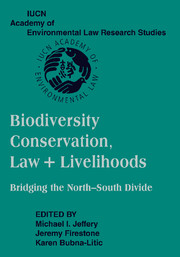 Biodiversity Conservation, Law and Livelihoods: Bridging the North-South Divide
Biodiversity Conservation, Law and Livelihoods: Bridging the North-South Divide Published online by Cambridge University Press: 31 July 2009
INTRODUCTION
This chapter investigates the legal and institutional aspects of the region-wide promotion of “community-based conservation and natural resource management” as an environmental governance mechanism in the Pacific Island Region. There is a clear consensus among stakeholders that community-based approaches should now form the core of in situ biodiversity conservation efforts in Pacific Island Countries (PICs). Justifications for adopting this approach are broadly consistent with those applied in other regions of the world where rural communities are collaboratively engaged in conservation and natural resource management initiatives. These justifications may be grouped into two broad categories. First, the responsible government agencies have limited technical and other capacity to coercively regulate citizens’ everyday resource uses. Second, various economic, geographic, cultural and historical factors, including prevalence of subsistence livelihoods, highly valued and contested communal land tenure arrangements, and the widespread persistence of customary authority and institutions combine to indicate that in Pacific jurisdictions participatory and collaborative conservation and natural resource management approaches are likely to be more successful than either centralised regulation or individual actors negotiating within a market.
During the past two decades, community-based conservation and natural resource management has been the focus of much regional, national, and subnational programmatic activity in Pacific island countries, but legal and institutional reform has in general not accompanied this paradigm shift in island conservation practice.
To save this book to your Kindle, first ensure [email protected] is added to your Approved Personal Document E-mail List under your Personal Document Settings on the Manage Your Content and Devices page of your Amazon account. Then enter the ‘name’ part of your Kindle email address below. Find out more about saving to your Kindle.
Note you can select to save to either the @free.kindle.com or @kindle.com variations. ‘@free.kindle.com’ emails are free but can only be saved to your device when it is connected to wi-fi. ‘@kindle.com’ emails can be delivered even when you are not connected to wi-fi, but note that service fees apply.
Find out more about the Kindle Personal Document Service.
To save content items to your account, please confirm that you agree to abide by our usage policies. If this is the first time you use this feature, you will be asked to authorise Cambridge Core to connect with your account. Find out more about saving content to Dropbox.
To save content items to your account, please confirm that you agree to abide by our usage policies. If this is the first time you use this feature, you will be asked to authorise Cambridge Core to connect with your account. Find out more about saving content to Google Drive.